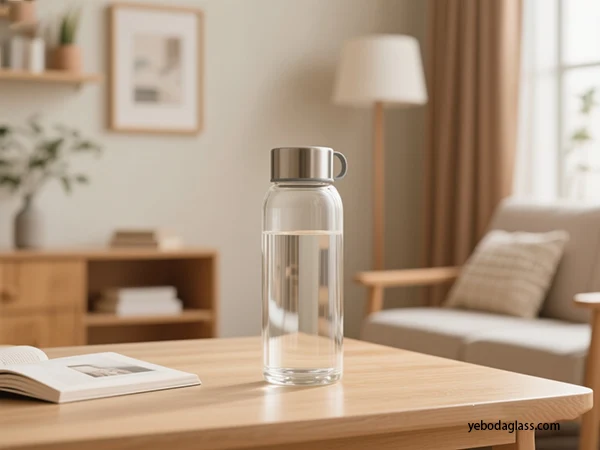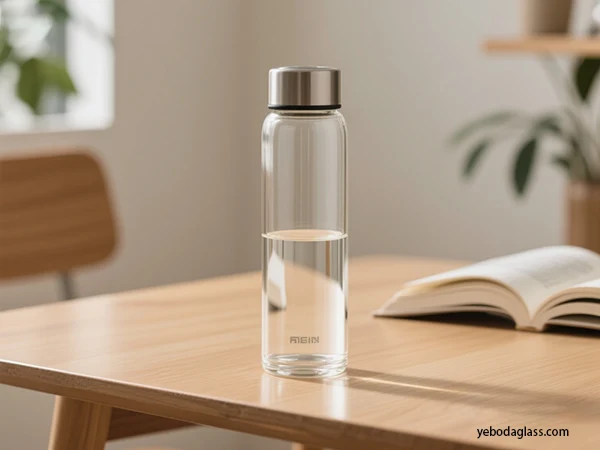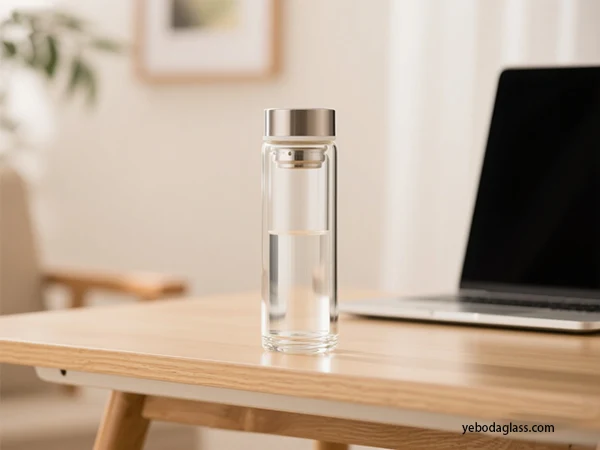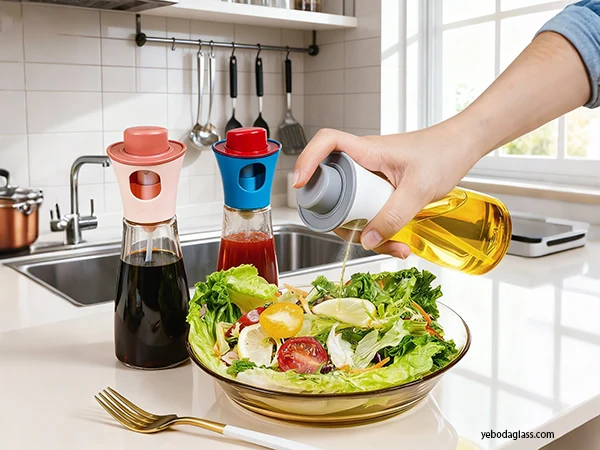Einführung
This report analyzes the wholesale purchase of custom glass water bottles, suppliers covers identification, adaptation, cost, lead time, quality assurance and risk mitigation. The increasing demand for solo-utilization plastics increases significant increase in glass packaging market. Glass provides better taste purity and is infinitely recycled by aligning with environmental consciousness. For buyers seeking a reliable partner, Ja, ja. offers end-to-end solutions from design to delivery, ensuring a seamless procurement process with a strong focus on quality control and sustainable practices. This report synthesizes research to make optimal procurement decisions, manage costs, ensure quality and inform stakeholders on navigating sourcing challenges.

Customization Options and Production Methods
Customization is key for branding. Various techniques offer different cost, durability, and aesthetic outcomes.
Printing and Decoration Techniques:
- Ceramic Screen Printing: Fires a ceramic layer onto glass for extremely durable, fused prints.
- Glass Printing: Similar to ceramic screen printing, firing a ceramic layer for precise designs.
- Organic Screen Printing: Uses less expensive organic inks, resulting in less durable prints.
- Digitaldruck: Transfers complex designs directly onto the Glasflaschen. Can be more expensive and time-consuming for large orders. Digital UV glass printing uses UV light for curing.
- Siebdruck: Cost-effective for large orders, ideal for logos. Requires a separate screen per color, impacting multi-color design time.
- UV Printing: Excellent for intricate, multi-color designs with vibrant results.
- Laser Engraving: An eco-friendly, permanent etching method, particularly effective on stainless steel.
- Frit Printing: Fuses powdered ink with glass during heating, offering high scratch resistance. It’s a premium, more costly option restricted to heat-tempered glass.
- Spray Coating: Applies translucent, transparent, or opaque inks for various effects. Durability may vary.
- Heat Transfer and Pad Printing: Less common but effective for specific designs and materials.
Material and Design Considerations for Printing:
Glass type (float or tempered) affects printing. Vector file formats (AI, EPS, SVG) are preferred for printing.
Cost and Durability Implications:
Screen printing is cost effective for large glass water bottles orders; Digital printing scored small runs. Organic ink is economical. Fit printing is premium. The durability varies, providing the highest longevity with ceramic and frit printing. Yeboda enhances this price proposal by providing expert guidance on the most suitable technique for each project, offers competitive pricing in all methods, and ensures extraordinary print durability through their state -of -the -art firing and quality control processes.
Material and Feature Specifications
Material and convenience options greatly affect functionality, aesthetics and costs.
Glass Type and Properties:
- Borosilikatglas: resistant to durable and thermal shock.
- recommended for better thermal shock resistance and chemical stability, premium brands or reusable bottle programs. The most common, food-safe (GRAS), silica, soda ash and limestone by the FDA are made.
- Flint Glass: Completely transparent with a minor green tint.
- Super Flint Glass: There is more clarity for premium appearance and no green tint.
General Bottle Capacity:
Glas Wasserflasche capacities typically range from 300ml to 1000ml (approximately 10 to 32 ounces), with common sizes including 550ml (18oz) and 750ml (25oz) options. Yeboda offers this full range of sizes from 300ml up to 1000ml.
To increase facilities:
- Silicon sleeve: grab and impact protection.
- Bamboo lids: often threaded for a safe seal, characteristic of a carry handle. Bamboo is Akshay and Biodegradable.
- Weitere Verbesserungen: neoprenepouches, custom colors, spray coating, frosted seodes, or etched designs are available.
- Cip diversity: Beyond bamboo, polypropylene plastic lids are also used.
Quality Assurance and Compliance Standards
Ensuring quality and safety for food and beverage products is paramount.

Quality Control Measures
- Raw material inspection: inspection of material for purity.
- In-process inspection: systematic inquiry during manufacturing.
- Finished Product Inspection: Automatic and manual check for defects.
- Testing Protocol: Physical property, chemical composition, heavy metal and microbial tests.
Food-grade Safety Standards
- FDA and EFSA Regulations: Compliance with American FDA and European Union EFSA rules for toxins and chemical migrations.
- Material protection: glass is generally safe, not to leaching chemicals or absorb odor. Borosilicate glass is preferred for safety and durability.
- Zertifikat: General certificates include BPA-free, LFGB and European Union Food-safe grades.
Relevant Industry Standards and Certificates
- ISO 7086-1: 2017: Ways of testing for lead and cadmium release.
- California proposal 65: compliance of products exported to California.
- China Compulsory Certification (CCC): For glass products in China.
Risk Management
Supply Series Risk
- Market instability: Availability of raw materials, recycling disabilities, and ups and downs in demand can lead to price increase and decrease.
- Mitigation: Diversity in suppliers, monitoring the supplier risk, and building a flexible supply chain.
Cost and Pricing Risk
- Transport Costs: Important components affected by distance, quantity, fuel prices and packaging 1. The cost of freight from Asia can be unstable.
- Government duties and tariffs: can increase the cost and interrupt the supply chains.
- Mitigation: Analysis of cost drivers, understand the seller margin, detect diverse transport methods, and interact on transparent pricing.
Quality and Operations Risk
- Qualitstandard Difference: Difference between domestic and international suppliers.
- Shipping Issues: Partial Shipment or MissCol.
- Mitigation: Install clear quality benchmarks, define the acceptance sampling level (AQLS), install a clear inspection system and attach third -party inspectors. Manage suppliers performance using major performance indicators (KPI) and service level agreements (Slas).
Land Political and Regulatory Risk
- Customs and Regulations: Compliance with international trade rules and customs withdrawal procedures may be delayed.
- Mitigation: Be informed about developing business rules and ensuring compliance.

Stability and Moral Thoughts
- Balance cost and environmental protection: a common challenge.
- Mitigation: Priority to environmentally friendly logistics, detect regional production, and establish a strong supplier participation.
Design and Intellectual Property
- Adaptation complexity: Complex design costs and lead time increase.
- Mitigation: Apparently define the design requirements, ensure manufacturing, and protect intellectual property.
Sourcing Strategies
- Suppliers Relationship Management: Build a strong, long -term partnership. Conversation strategy: Be well prepared, understand your best option (BATNA), Understand Leverage Volume, and focus on the total value.
- Sourcing agent: can streamlide the process and reduce the risk, especially in international markets.
Recommendations and Next Stage
Based on research, the following recommendations are provided:
Suppliers Selection Structure
- Develop a long list: Compile possible suppliers based on their expertise, production capacity, geographical location and level of OEM/ODM capabilities.
- Shortlist and Review: Evaluate the availability of suppliers websites, reviews, certificates and quotes/samples. Priority to suppliers with proven experience in custom glass bottles manufacture.
- Request a detailed quotation: Get a comprehensive quotation, get details of price levels, minimum order volume (amOQ), optimization cost, lead time, terms of payment and shipping methods.
- Conduct of proper hard work: Consider conducting an on-site travel or third party inspection to verify the capabilities and quality control of the supplier.
Gesprächsstrategie
- Leverage Order Volume: Communicate the projected order volume and repeat business capacity to secure favorable pricing.
- Note the total value: In addition to the unit value, interact on the terms of payment, lead time, shipping costs and post -sales support. Try for test orders: Before signing a large order, interact on a small test order to assess quality and reliability.
- Build the partnership: Extricately try for profitable agreements and promote long -term relationships.
- Clear specification: Ensure that all adaptation, quality standards and delivery programs are clearly defined in the contract.
Quality Assurance and Risk Management
- Establish a clear quality assurance agreement: Define quality posts in the production process and require suppliers to follow suppliers.
- Contract safety measures: Quality standards, acceptance criteria, warranty and penalty sections include.
- Diversity to suppliers (if possible): Reduce the disruption of the supply chain for vital components or high-length products.
- Understand the lead time: Consider complete production and shipping time including buffer period.
Specific Ideas for Custom Glass Water Bottles
The common benefits of custom glass water bottles include:
- Brand growth: Premium aesthetics exposes brand values, especially to brands focused on stability. The clarity and purity of the glass increases the product recognition.
- Stabilität: Glass is environmentally friendly and can be recycled and recycled, recycled and recycled, fulfilling consumer demand for permanent products. Pure taste: The glass does not have any smell or chemical, preserving the original taste.
- Adaptation capacity: Unique product is obtained through optimization of discrimination size, shape, color and branding.
To make direct comparison, further research is required in Yiboda’s specific manufacturing processes, material quality, adaptation services, pricing and stability initiatives.

Sourcing Roadmap
- Necessary Definition: Glass water bottle specifications (volume, size, material, CAP), outline adaptation requirements, budget and timeline.
- Suppliers Research and Development: Identify and contact potential suppliers.
- Request for quotation and quotation evaluation: Compare detailed quotes including price, minimum order volume, lead time and conditions.
- Sample approval: Equal order samples and their quality, design accuracy and functionality.
- Conversation and contract final form: interact on terms and eventually sign a complete contract.
- Production Monitoring: Keep regular communication, track progress and solve issues.
- Quality Inspection: Pre-shipment to complete the product to meet the inspection operating standards.
- Logistics and delivery: Coordinate shipping and delivery to ensure timely receipt of goods. Following this structured approach, it ensures that bulk customized glass water bottle sourcing is efficiently directed to meet specific requirements and objectives.




